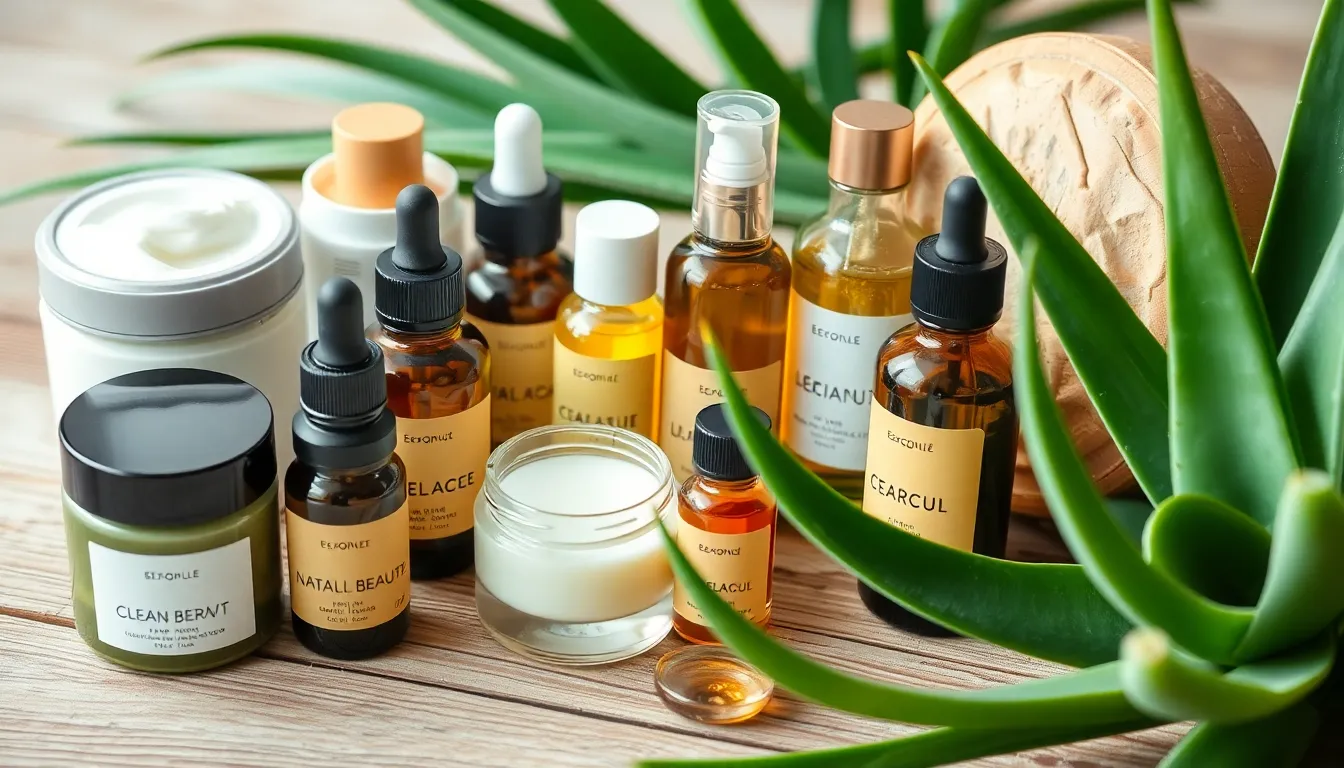In a world where “clean” isn’t just for your kitchen counter, the beauty industry is stepping up its game. Clean beauty products are here to save the day, banishing nasty chemicals and embracing nature’s finest ingredients. Who knew that looking fabulous could also mean being kind to your skin and the planet?
Overview Of Clean Beauty Products
Clean beauty products prioritize ingredient transparency and safety. These products often avoid harmful chemicals such as parabens, sulfates, and synthetic fragrances. Instead, many brands emphasize the use of natural and organic ingredients sourced from plants, minerals, and other sustainable resources.
Market demand for clean beauty has surged, driven by increased consumer awareness of potential toxins in traditional beauty products. A report from Statista indicates that the global clean beauty market is expected to reach $22 billion by 2024. Consumers now seek products that not only benefit their skin but also align with their environmental values.
Certifications play a crucial role in identifying clean beauty products. Terms like “non-toxic,” “organic,” and “cruelty-free” influence purchasing decisions. Brands often display third-party certifications on their packaging, helping consumers make informed choices.
Variety abounds within the clean beauty sector. From skincare essentials like cleansers and moisturizers to makeup products such as foundation and lipstick, options cater to diverse skin types and concerns. Each product focuses on enhancing natural beauty while minimizing exposure to harmful substances.
Innovation is evident as brands develop new formulas and sustainable packaging methods. Some manufacturers even implement refillable or recyclable containers to reduce waste. As a result, clean beauty represents a holistic approach to personal care, emphasizing health for both individuals and the planet.
Adaptation within the industry reflects changing consumer preferences. Retailers increasingly allocate shelf space to clean brands, responding to the growing demand. Consequently, the clean beauty movement continues to gain momentum, reshaping beauty standards and practices worldwide.
Key Ingredients In Clean Beauty

Clean beauty products prioritize ingredient transparency, focusing on natural components that are safe for both the skin and the environment.
Natural Ingredients
A variety of natural ingredients enhance the efficacy of clean beauty products. Ingredients like aloe vera, renowned for its soothing properties, provide hydration and protection. Jojoba oil serves as a natural emollient, helping to balance skin’s moisture levels. Additionally, botanical extracts, such as green tea and chamomile, offer antioxidant benefits, reducing signs of aging and inflammation. Other common ingredients include shea butter, a deeply moisturizing agent, and essential oils, which not only fragrance but also amplify therapeutic effects. These natural options resonate with consumers seeking effective alternatives to chemicals.
Harmful Chemicals To Avoid
Avoiding harmful chemicals is crucial when choosing clean beauty products. Parabens, often used as preservatives, can disrupt hormonal balance and are linked to health concerns. Sulfates, found in cleansers, strip natural oils, leading to dryness and irritation. Phthalates, commonly used in fragrances, may pose risks to reproductive health. Additionally, artificial colors and synthetic fragrances can cause allergic reactions and skin irritation. Propylene glycol, while effective for moisture retention, may trigger sensitivities. Being aware of these chemicals empowers consumers to select products that align with their health and values.
Benefits Of Using Clean Beauty Products
Clean beauty products offer numerous advantages, ranging from improved skin health to a positive environmental impact.
Skin Health
Using clean beauty products enhances skin health by minimizing the risk of irritation and allergic reactions. Natural ingredients like aloe vera and jojoba oil nourish the skin without harsh chemicals. These products often contain antioxidants from botanical extracts, which protect against environmental stressors. Consumers find that formulations free from parabens and sulfates lead to clearer, more radiant skin. Additionally, ingredient transparency helps individuals select products that suit their skin types and concerns effectively. Prioritizing skin health not only results in visible improvements but also fosters a deeper connection between the user and their skincare routine.
Environmental Impact
Clean beauty products play a critical role in promoting sustainability and reducing environmental harm. Many brands create sustainable packaging solutions, opting for refillable or recyclable materials to minimize waste. By avoiding harmful chemicals, these products contribute to healthier ecosystems by not polluting water sources. Innovation in the clean beauty sector encourages the use of responsibly sourced ingredients, benefitting both consumers and the planet. Supporting such brands aligns with a growing consumer demand for environmentally friendly practices. Choosing clean beauty not only uplifts personal health but also reflects a commitment to preserving the environment for future generations.
Popular Clean Beauty Brands
Several brands lead the clean beauty movement, each with a distinct commitment to natural ingredients and sustainability.
Tatcha focuses on Japanese botanical ingredients, providing luxurious skincare that nourishes the skin with every application.
Beautycounter emphasizes strict ingredient standards, ensuring that its products are both effective and safe, while also advocating for legislation to improve beauty product regulations.
RMS Beauty champions raw, food-grade ingredients in its makeup, blending skincare and cosmetics seamlessly without compromising on purity.
ILIA Beauty combines skincare benefits with high-performance color cosmetics, catering to consumers who seek both beauty and wellness in their routines.
100% Pure offers a wide array of cosmetics and skincare, using fruit pigments and natural elements, ensuring every product is free from harmful additives.
Herbivore Botanicals excels at crafting vegan, cruelty-free products, focusing on botanical ingredients that promote skin health and environmental sustainability.
Kjaer Weis presents luxury makeup in refillable packaging, marrying high-quality ingredients with a commitment to reducing waste.
Eminence Organic Skin Care prides itself on using organic ingredients sourced from sustainable farms, delivering potent skincare without harmful effects on the planet.
Fenty Beauty introduced a wide shade range while prioritizing ethical practices, ensuring inclusivity without compromising ingredient quality.
Alima Pure creates mineral makeup that emphasizes natural ingredients, appealing to consumers who prefer to avoid synthetic chemicals in their beauty products.
These brands represent a growing commitment to clean, effective beauty solutions, showing that consumers can choose products that align with both personal health and environmental responsibility.
Tips For Choosing Clean Beauty Products
Selecting clean beauty products involves careful consideration of several key factors. Focus on ingredient transparency; reviewing product labels ensures understanding of what is included. Look for certifications such as “organic” or “cruelty-free,” as these labels provide basic assurance of ethical practices.
Consider the brand’s commitment to sustainability; many leading brands adopt eco-friendly packaging and ethical sourcing. Research ingredients like aloe vera, jojoba oil, and botanical extracts that are known for their skin benefits while being safe for the environment.
Avoid products with harmful chemicals; steer clear of parabens, sulfates, and synthetic fragrances. Read reviews and testimonials to see how others have experienced the products, giving insight into effectiveness and potential reactions.
Explore various brands recognized for their clean beauty standards. Brands like Tatcha and Beautycounter lead in combining skincare with ethics, while others like 100% Pure and Herbivore Botanicals emphasize vegan formulations. Evaluate individual skin types and needs, as not every product suits every person.
Test products when possible; consider sampling items to observe how skin responds. Understand that clean beauty can also include high-performance products without compromising safety or ethics.
Stay updated on industry trends; clean beauty innovations, including refillable packaging, are increasingly common. Making informed choices empowers consumers to prioritize health and align with values related to sustainability and safety.
The clean beauty movement is transforming the way consumers approach personal care. By prioritizing natural ingredients and sustainability, it empowers individuals to make choices that benefit both their skin and the planet. As awareness grows around the importance of ingredient transparency and the dangers of harmful chemicals, more brands are stepping up to meet this demand.
With a variety of options available, consumers can find products that cater to their unique needs while supporting ethical practices. Embracing clean beauty isn’t just a trend; it’s a commitment to healthier living and a more sustainable future. By choosing clean beauty products, individuals contribute to a larger movement that values health, safety, and environmental responsibility.





